Marketing Module 2
1/85
There's no tags or description
Looks like no tags are added yet.
Name | Mastery | Learn | Test | Matching | Spaced |
|---|
No study sessions yet.
86 Terms
the big picture
segmentation → targeting → (re)positioning
market segmentation
how is a firm supposed to make sense of a huge market?
process of dividing market into smaller groups (segments)
groups designed to have similar wants and need
cluster analysis
firms plot their core competencies and target groups with most sale potential
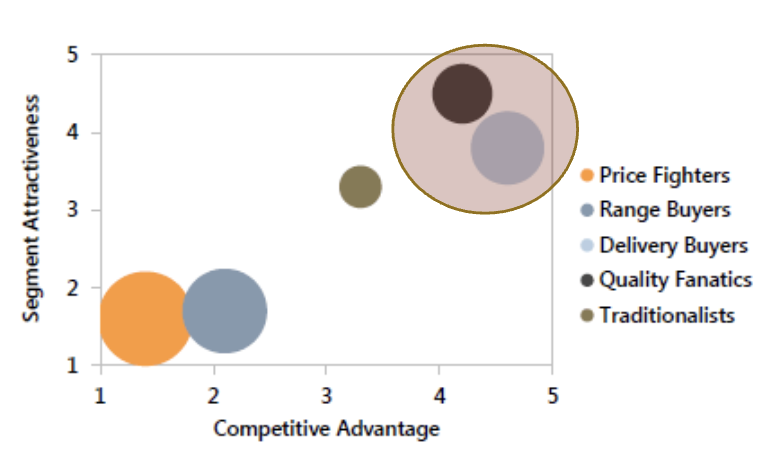
targeting
after segmentation, firms develop new products or reposition olf ones to target a specific group
ex. Harley davidson targeting millennials
targeting approach- undifferentiated
entire market is target market
1 marketing mic
homogeneous market
rarely used anymore
targeting approach- multiple products and multiple segments
marketing diff products more expensive than producing just one
justified if: serve customers needs better, doesn’t reduce quality or increase price, adds to sales
Darden restaurant group
olive garden
-longhorn
ruth’s chris steakhouse
eddie v
bahama breeze
capital grille
yard house
cheddars
seasons
targeting approach: segments of one
each customer has unique wants and needs
mass customization
targeting approach: niche markets
one product focused to meet needs of one very focused segment
segmentation bases
demographics
gender
age
ethnicity
education
religion
geographic
psychographics- personality, motives, lifestyle
behavioristic- usage/ volume, benefits, loyalty, price sensitivity
use- related segmentation
usage rate- heavy users, medium users
awareness status- aware, unaware, etc
brand loyalty- none, some, strong
VALS
value and lifestyles survey
helps classify customers based on psychological characteristics that are correlated w purchasing behavior, related to key demographics
sales forcast
amount of a product a company expects to sell during a specific period at a specified level of marketing activities
scientific or arbitrary
depends on cost, product, market characteristics, etc
time series analysis
using historical sales data to discover patterns in firm’s sales
trend analysis- aggregate sales data from many years to determine general trends
cycle analysis- analyzing sales for three to five years to assess consistent fluctuations
seasonal analysis- daily, weekly, monthly sales for seasonal influence
regression analysis
predicting sales based on finding a relationship between past sales and one or more independent variables
also requires the use of historical sales data
useful when precise association between variables can be established and when historical data is extensive
cannot use this method for new products
test market
making a product available to buyers in one or more test areas and measuring purchases and consumer responses
info abt customers rather than purchase behavior
estimating sales of new products
time consuming + expensive
product positioning
process of developing and maintaining a product image in the minds of consumers
product position results from customers’ perceptions of a product’s attributes relative to those of competing products.
positioning bases
←benefit, price/quality, time of use, product user, product class, country of origin→
perceptual mapping
done with multidimensional scaling (mds)
position objects in a multidimensional space according to similarities and customer preferences
ratings on both objective and percieved measures
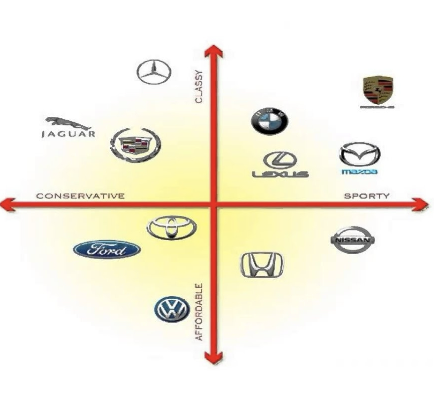
(re)positioning
ex: stagnant sales and an aging customer base led to Winnebago to seek younger more active customers
fsu
mcdonalds: family → cafe
marketing research
process of designing, gathering, analyzing, and reporting info that may be used to understand customers and solve a marketing problem
net promoter score
“how likely are you to recommend us to a friend?”
(9-10)- (0-6)
promoters-detractors
marketing research: new product design
ex: ketchup packets
starbucks non dairy options
marketing research: retail heat maps
where customers are in space
stores optimize displays
marketing research: waiting times
increased wait times signal higher quality
customers choose slow short lines rather than fast long lines
marketing research: new product development
coca cola used the freestyle machine to gather market research data about which new flavors would sell well
ex: cherry sprite
where did marketing research come from?
1980’s
TQM movement (Deming and Juran)
customer orientation
research to find customer reaction to a product
compare product to competitors
find problems w a product
where is marketing research now?
BIG data
data sets too large r complex to be dealt with by traditional data- processing
what customers are doing/not
text mining process
retrieves relevant sets of data
runs algorithms
analytical modeks
applies findings for application such as sentiment analyiss
prepares data visualizations and dashboards to share results
why is MR important?
managers answers to important questions
loyal customers
unhappy customer tells 9-12 others, happy tells 1-5
14X more likely to sell to an existing customer
cost to replace salesperson is 3x the departing employee’s salary
gives e-commerce managers answers to questions
82% of online consumers check multiple websites before purchasing
amazon and ebay starting points
86% online consumers aren’t loyal to one brand
cluster analysis
statistical analysis technique that identifies customer segments
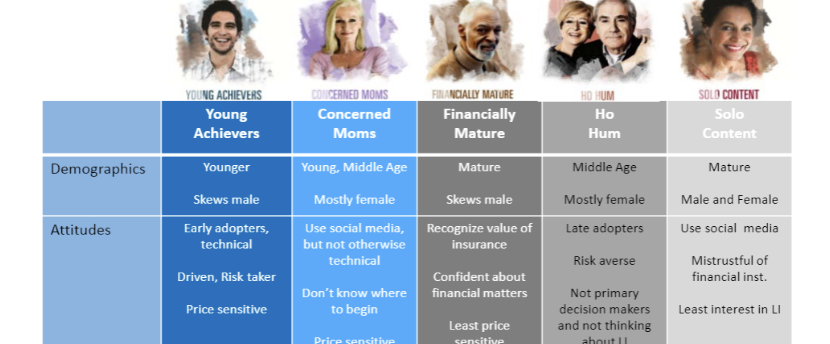
conjoint anlysis
statistical analysis technique that gives sensitivity info
applied research
research designed to solve a specific problem
basic research
research designed to extend knowledge of a marketing phenomena
marketing research process
problem definition
research design
sampling
data gathering
data analysis
report preparation
the problem definition
symptoms vs problems
sales are down
decreased foot traffic
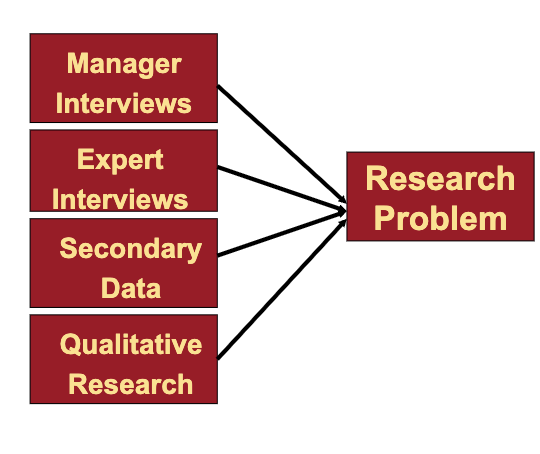
the research design
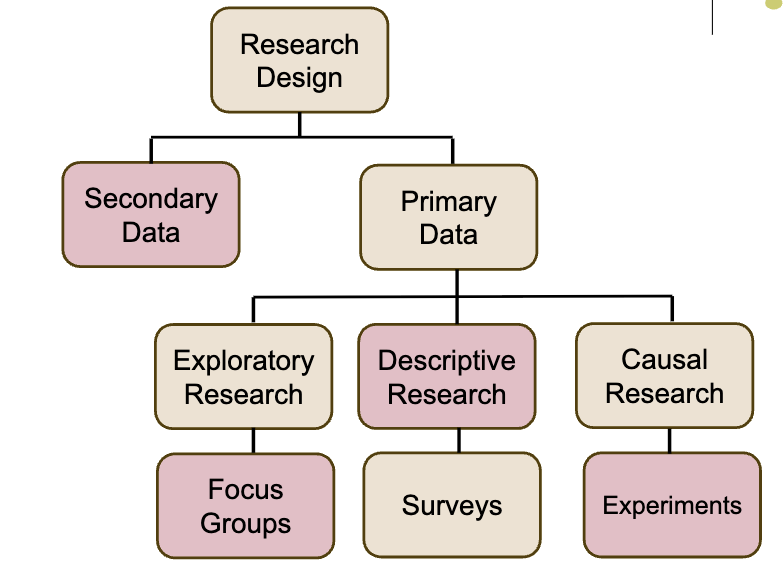
secondary data
information collected for a purpose other than research at hand
ACSI - american customer satisfaction index
primary data
info gathered specifically for the research objectives at hand
exploratory
describes less structures data collection methods
focus groups
focus groups
flexible, group discussion of a product, ad, concept
twitter went form podcasts to now from focus groups
descriptive research
describes characteristics of a population
survey research
online
mail
telephone
personal interview surveys
Qualitrics
provider of subscription software for collecting and analyzing data for market research
causal research
cause and effect
experiments
correlation vs causation
A/B testing
experimental method used in industry where A and B are presented
whats more appealing
disney uses
buyer behavior
marketing and psychology interact
consumer motivations and why or why not aspect of purchase related decisions
assumption of rational choice
now, we understand irrationality is the real invisible hand that describes human decision making
price anchoring
powerful mental shortcuts that restrict how much companies can charge for similar products
how much would you pay for this product?
ex: la croix
make price sufficiently diff so it breaks anchored price (redbull vs cola)
situational influence
halloween time- halloween things sell more
recess sell more
orange and black clothing
rational?
consumers more likely to do a task for a free $3 cup of coffee than $3 bc of the word FREE
endowment effect
people value objects they own more than the same object if they don’t own it
explains how people over-value houses
framing
dave thomas introduced triple burger so the double burger wouldn’t seem as big in comparison
psychological framing
involvement and problem solving
speak to consumers’ motivation to seek info anf expend effort on purchase
high involvement products- careful consideration, visible to others, risky, expensive
low involvement- less expensive, less risk
involvement
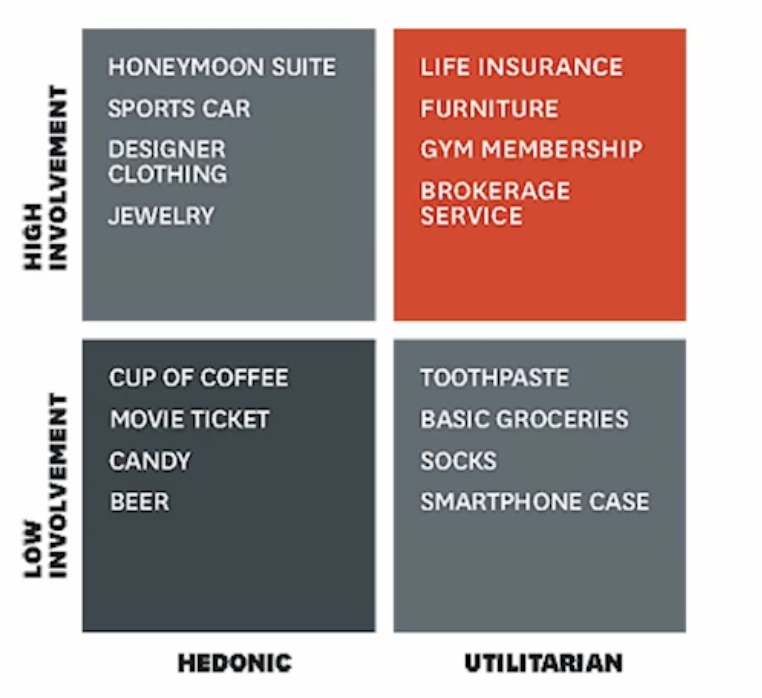
problem solving
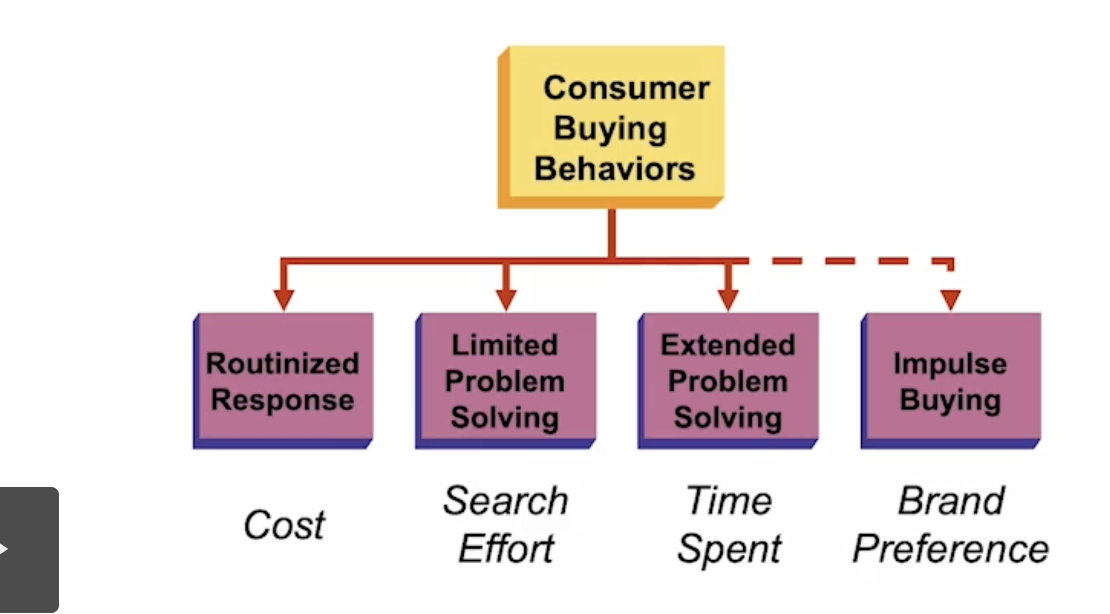
buyer behavior: routinized/ habitual decision making
little to no conscious effort
how do brands help consumers?
want cookies? oreos.
brands help us not think
buyer behavior: limited problem solving
requires moderate amount of time for info gatherinf
familiar with product class, not brand
restaurants, clothes
buyer behavior: extended problem solving
consumer gains as much info as possible from both internal and external sources (memory + advertising)
ex: colleges
consumer decisions

maslow’s hierarchy
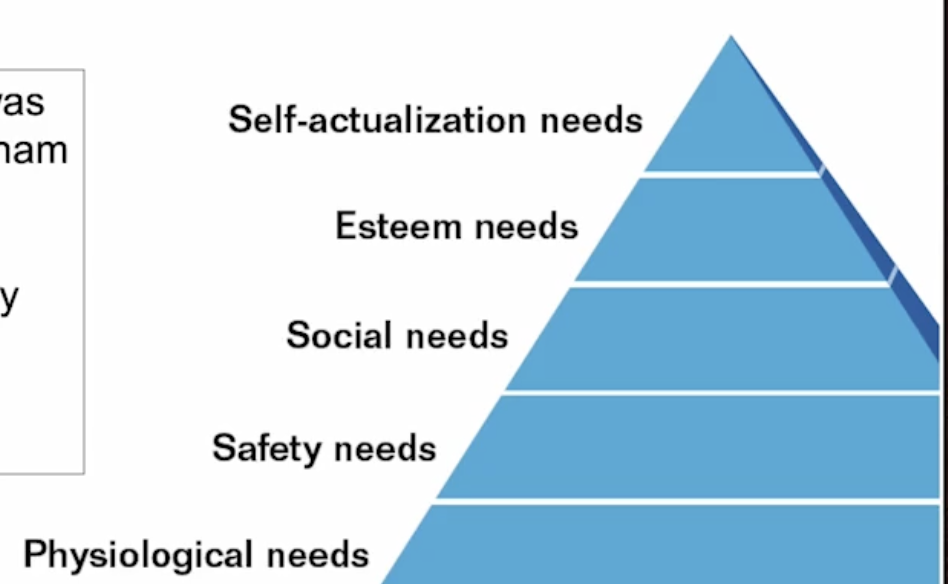
information seaech
internal vs external
internal search: memory
external: rate my professor
evaluatoon of alternatives
consideration/ evoked set
products alr in memory (retrieval set)
and those prominent in retail environment
ex: candy bars
product selection
most consumers are “cognitive misers”
mental shortcuts
higher price + higher quality - not true
country of origin- german cars
post-purchase
(dis) satisfaction- emotional reaction to purchase decision
cognitive dissonance- buyers doubts shortly after a purchase abt whether the decision was right one
generations
generations share similar values and beliefs
millennials buy more hot sauce, gas station food, snakes, etc
zero consumer
Mckinsey identified as a recent trend, consumers shopping across channels, little loyal, fast shipping sustainable products
zero boundaries- diff sources of info (influencers)
zero in the middle- no middle of market, scrimping or splurging
zero loyalty- switching brands
zero patience- less willing to wait
net zero- sustainability
alibaba
chinese equivalent of amazon
global markets
largest companies in U.S.
how foreign markets will react to a domestic product
global trend: inflation
global phenomenon
bigger than U.S. issue
culture and meaning
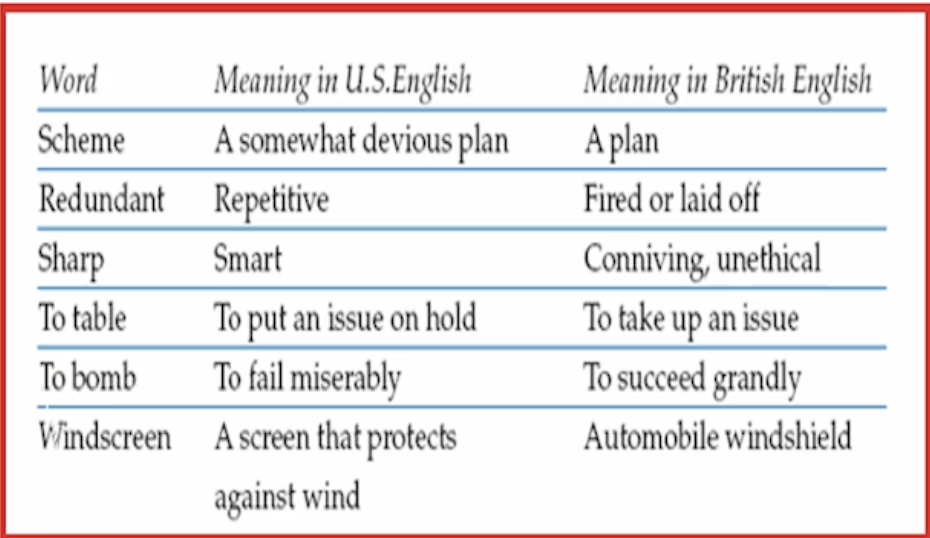
dialect and meaning
coca cola meant “bite the wax tad pole” and “female horse stuffed w wax” in other languages
coke researched 40,000 chinese characters to decide one
cultural fails
nike and ireland
black and tan
cultural differences
when to eat dinner
taking naps
how much they work
colgate culture example
-in rural india they use ash and weed
-colgate matched that
global trade: balance of trade
aka trade deficit
a country’s difference between exports and imports
U.S. has 90 billion trade deficit
export more than import
countries with largest trade deficit
china
mexico
japan
germany
vietnam
understanding global markets
sociocultural forces
economic forces
political, legal
ethical and social responsibility
competitive
technological
adaption/ standardization
modifying elements of the marketing program to accomodate specific customer requirements in individual foreign market
auto making for uk markets
similar to segmentation
U.S. consumers 2x as likely to spread negative words abt bad service
U.S. consumers 2x as likely to seek revenge online
UK consumers just as likely to spread positivity
adaptation at mcdonalds
change menu due to taste of foriegn markets
What is a luxury brand in China but not here?
Pizza Hut
What is a Christmas tradition in Japan?
KFC
standardization
efforts to make marketing program elements uniform in an effort to target entire countries, or even global market-lace, with a similar product/service
not usually advisable
standardization vs. adaptation
standardization pursued when global market segments exist, products have universal specifications
adaptation pursued when market has unique characteristics based on language, culture, regulations, income level, etc
gray “marketing”
legal importation of genuine products into a country by other than authorized intermediaries
by product low price in one country, sell it to another for higher price
ex: textbooks
Jack Ma
co founder of alibaba
amazon mechanical turk
crowdsourcing marketplace that connects you with an on-demand, scalable, human workforce to complete tasks.